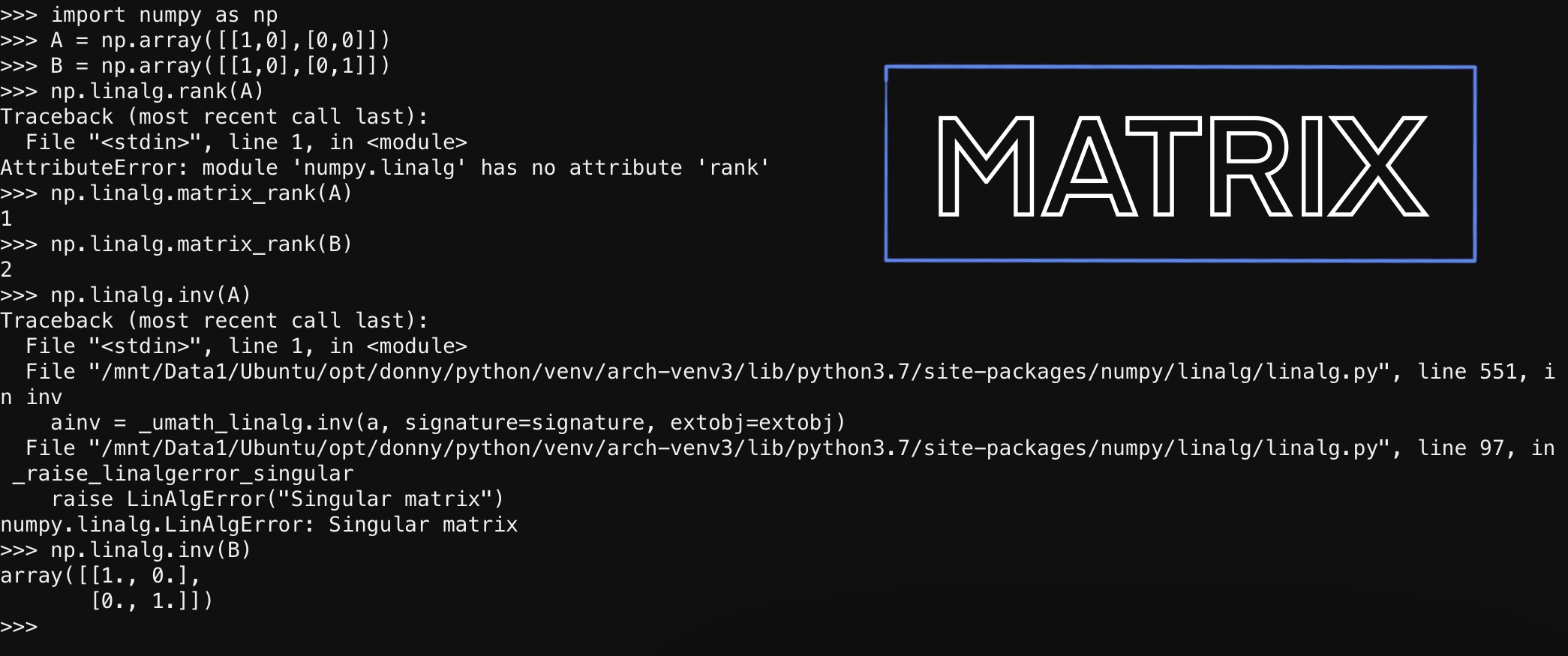
Matrix
Basic Operations
- Matrix Product (Dot Product)
- Matrix Division
- Matrix Multiplication (Hadamard Product)
Matrix Operations
- Matrix Transpose
- Matrix Inversion
- Matrix Trace (the sum of the main diagonal elements)
- Matrix Determinant
- Matrix Rank (the maximum number of linearly independent columns)
Matrix Factorization (?)
Ref: Linear Algebra Cheat Sheet Python Code
Others:
- Unitary Matrix
A matrix \( U \) that satisfies - Minor Matrix
- Adjugate Matrix
For square matrix A, \( adj(A) = C^{T} \) , \( C = (-1)^{i+j} M_{i,j} \) , where \( M_{i,j} \) is the (i, j) minor of A. - Conjugate Transpose
\( (A^{*})_{i,j} = \overline{A_{j,i}} \) , for complex number \( c = a+ib \) , \( \overline{c} = a-ib \) - Orthogonal Matrix
A matrix that satisfy \( A^{T} = A^{-1} \)
Matrix Product
Matrix product is produced by taking i-th row of the first matrix and j-th column of the second matrix and calculate dot product of the two vectors as the (i, j) element in the result matrix.
Given
$$ A = \begin{bmatrix} 1 & 2 & 1 \\ 3 & 4 & 2 \ \end{bmatrix} \\ B = \begin{bmatrix} 1 & 2 \\ 2 & 1 \\ 1 & 2 \ \end{bmatrix} \\ $$
then,
$$ AB = \begin{bmatrix} 6 & 6 \\ 13 & 14 \end{bmatrix} $$
Matrix Division
Matrix Division makes use of the following property:
$$ AX = B \\ A^{-1}AX = A^{-1}B \\ X = A^{-1}B $$
where \( A^{-1} \) is the inversion of A. Therefore A must be invertible (see Invertible Matrix, in short a matrix is invertible if it has full rank).
See the Matrix Inversion section below for more information.
Matrix Inversion
An n-by-n Matrix A is invertible if there exists an n-by-n matrix B such that \( BA = BA = I_n \) . And B is called the inverse of A.
Only square matrices can be invertible. Non-square matrix may have left-inverse or right-inverse.
A square matrix that is not invertible is called singular or degenerate. A square matrix is singular if and only if its determinant is zero.
Given
$$ A = \begin{bmatrix} 1 & 3 & 3 \\ 1 & 4 & 3 \\ 1 & 3 & 4 \end{bmatrix} $$
The inverse of A, \( A^{-1} \) is calculated by
$$ [A | I ] = \begin{bmatrix} 1 & 3 & 3 & | & 1 & 0 & 0 \\ 1 & 4 & 3 & | & 0 & 1 & 0 \\ 1 & 3 & 4 & | & 0 & 1 & 0 \end{bmatrix} $$
Transform it using Gaussian Elimination (aka. row reduction) so that the left side becomes an identity matrix,
$$ [I | A^{-1}] = \begin{bmatrix} 1 & 0 & 0 & | & 7 & -3 & -3 \\ 0 & 1 & 0 & | & -1 & 1 & 0 \\ 0 & 0 & 1 & | & -1 & 0 & 1 \\ \end{bmatrix} $$
Therefore, \( A^{-1} \) is
$$ A^{-1} = \begin{bmatrix} 7 & -3 & -3 \\ -1 & 1 & 0 \\ -1 & 0 & 1 \\ \end{bmatrix} $$
The inverse can also be calculated as:
$$ A^{-1} = \frac{1}{det(A)} adj(A) $$